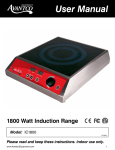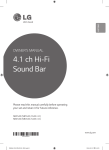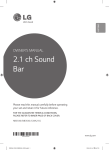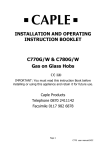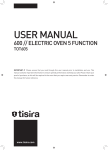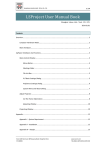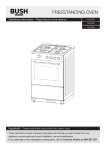Download Manual - Appliance Support
Transcript
EN Instructions Manual FREESTANDING PRODUCTS Instructions Manual Safety & Installation Please read carefully this manual before installation & first use Service Helpline: 0333 577 7238 CONTENTS 2 PART-1: SAFETY WARNINGS..................................................................4 PART-2: INSTALLATION AND PREPARATIONS FOR USE..................12 2.1 Ventilation requirements..................................................... 12 2.2 Installation of product.......................................................... 13 2.3 Gas connection................................................................... 15 2.4 Gas conversion................................................................... 18 2.5 Electric connection and safety (If available)....................... 22 2.6 Adjustment of feet............................................................... 23 3.1 Cleaning.............................................................................. 24 PART-3: CLEANING AND MAINTENANCE............................................24 3.2 Maintenance....................................................................... 29 PART-4: SERVICE AND TRANSPORT...................................................30 4.1 Basic troubleshooting before contacting service ............... 30 4.2 Information related to transport........................................... 31 3 Dear Customer, Our goal is to offer you, high quality products that exceed your expectations. Your appliance is produced in modern facilities and is carefully, particularly tested for quality. This manual is prepared in order to help you use your appliance, which has been manufactured using the most recent technology with confidence and maximum efficiency. Before using your appliance, carefully read this guide which includes basic information to safe installation, maintenance and use. Please contact your nearest Authorized Service centre for the installation of your product. CE Declaration of conformity This appliance has been designed to be used only for home cooking. Any other use (such as heating a room) is improper and dangerous. This appliance has been designed, constructed and marketed in compliance with: -Gas appliances directive, 2009/142/EC -Low voltage directive, 2006/95/EC -EMC directive, 2004/108/EC -CE marking directive, 93/68/EEC * Visuals used in this user manual are schematic and may vary depending on model. PART-1: SAFETY WARNINGS 4 Read these instructions carefully and completely before using your appliance and keep it in a convenient place for reference when necessary. This manual is prepared for more than one model in common. Your appliance may not have some of the features that are explained in this manual. Pay attention to the expressions that have figures, while you are reading the operating manual. General Safety Warnings 1. This appliance can be used by children aged from 8 years and above and persons with reduced physical, sensory or mental capabilities or lack of experience and knowledge if they have been given supervision or instruction concerning use of the appliance in a safe way and understand the hazards involved. Children shall not play with the appliance. Cleaning and user maintenance shall not be made by children without supervision. 2. WARNING: The appliance and its accessible parts become hot during use. Care should be taken to avoid touching heating elements. Children less than 8 years of age shall be kept away unless continuously supervised. 3. WARNING: Unattended cooking on a hob with fat or oil can be dangerous and may result in fire. NEVER try to extinguish a fire with water, but switch off the appliance and then cover flame e.g. with a lid or a fire blanket. 5 4. WARNING: Danger of fire: do not store items on the cooking surfaces. 5. WARNING: If the surface is cracked, switch off the appliance to avoid the possibility of electric shock. 6. For hobs incorporating a lid, any spillage should be removed from the lid before opening. The hob surface should be allowed to cool before closing the lid. 7. The appliance is not intended to be operated by means of an external timer or separate remote-control system. 8. WARNING: In order to prevent tipping of the appliance, the stabilizing brackets must be installed. (For detail information please read the anti-tilting kit set guide.) 9. During use, the appliance becomes hot. Care should be taken to avoid touching heating elements inside the oven. 10. During use, handles held for short periods in normal use can get hot. 11. Do not use harsh abrasive cleaners or sharp metal scrapers to clean the oven door glass and other surface as they can scratch the surface, which may result in shattering of the glass or damage to the surface. 12. Do not use steam cleaners for cleaning the appliance. 6 13. WARNING: Ensure that the appliance is switched off before replacing the lamp to avoid the possibility of electric shock. 14. CAUTION: Accessible parts may be hot when the cooker or grill is in use. Young children should be kept away. 15. Your appliance is produced in accordance with all applicable local and international standards and regulations. 16. Maintenance and repair work must be made only by authorized service technicians. Installation and repair work carried out by unauthorized technicians may endanger you. It is dangerous to alter or modify the specifications of the appliance in any way. 17. Prior to installation, ensure that the local distribution conditions (nature of the gas and gas pressure or electricity voltage and frequency) and the requirements of the appliance are compatible. The requirements for this appliance are stated on the relevant label. 18. CAUTION: This appliance is designed only for cooking food and is intended for indoor domestic household use only and should not be used for any other purpose or in any other application, such as for non-domestic use or in a commercial environment or room heating. 19. Do not try to lift or move the appliance by using door handle. 7 20. This appliance is not connected to a combustion products evacuation device. It shall be installed and connected in accordance with current installation regulations. Particular attention shall be given to the relevant requirements regarding ventilation. 21. If after 15 seconds the burner has not lit, stop operating the device, open the compartment door and wait at least 1 minute before attempting a further ignition of the burner. 22. These instructions are only valid if the country symbol appears on the appliance. If the symbol does not appear on the appliance, it is necessary to refer to the technical instructions which will provide the necessary instructions concerning modification of the appliance to the conditions of use of the country. 23. All possible security measures have been taken to ensure your safety. Since the glass may break, care should be taken while cleaning to avoid scratching. Avoid hitting or knocking the glass with accessories. 24. Ensure that the supply cord is not wedged during the installation. If the supply cord is damaged, it must be replaced by the manufacturer, its service agent or similarly qualified persons in order to prevent a hazard. 25. While the oven door is open,do not let children climb on the door or sit on it. 8 Installation Warnings 26. Do not operate the appliance before it is fully installed. 27. The appliance must be installed by an authorized technician and put into use. The producer is not responsible for any damage that might be caused by defective placement and installation by unauthorized people. 28. When the appliance is unpacked, make sure that it has not been damaged during transportation. In case of any defect; do not use the appliance and contact a qualified service agent immediately. As the materials used for packaging (nylon, staplers, styrofoam...etc) may cause harmful effects to children, they should be collected and removed immediately. 29. Protect your appliance against atmospheric effects. Do not expose it to effects such as sun, rain, snow, excessive humidity etc. 30. The surrounding materials of the appliance (cabinet) must be able to withstand a temperature of min 100°C. During usage 31. When the product is operated for the first time, a certain smell will emanate from the insulation materials and the heater elements. Before using the cooker for the first time, operate it empty at the maximum temperature for 45 minutes. At the same time, the environment in which the product is installed, should be well ventilated. 9 32. While opening the oven door during or after operation, step back to avoid the hot steam coming out of the oven. There may be a risk of burns. 33. Do not put flammable or combustible materials, in or near the appliance when it is operating. 34. Always use oven gloves to remove and replace food in the oven. 35. Do not leave the cooker while cooking with solid or liquid oils. They may catch fire under extreme heating conditions. Never pour water on to flames that are caused by oil. Cover the saucepan or frypan with its cover to choke the flame and turn the cooker off. 36. Always position pans over the centre of the cooking zone, and turn the handles to a safe position so they cannot be knocked or grabbed. 37. If the product will not be used for a long period of time, turn the main control switch off. Also when not using a gas appliance, turn the gas valve off. 38. Make sure the appliance control knobs are always in the “0” (stop) position when it is not used. 39. The trays incline when pulled out. Be careful not to let hot liquid spill over. 40. CAUTION: The use of a gas cooking appliance results in the production of heat, moisture and products of 10 combustion in the room in which it is installed. Ensure that the kitchen is well ventilated especially when the appliance is in use, keep natural ventilation holes open or install a mechanical ventilation device (mechanical extractor hood). 41. Prolonged intensive use of the appliance may call for additional ventilation, for example opening of a window or more effective ventilation, for example increasing the level of mechanical ventilation where present. 42. While using the grill burner, keep the oven door open and always use the grill deflector shield supplied with the product. Never use the grill burner with the oven door closed. 43. CAUTION: Glass hob lids may shatter when heated. Turn off all the burners before shutting the lid. The hob surface should be allowed to cool before closing the lid. 44. When the door or drawer of the oven is open, do not leave anything on it. You may unbalance your appliance or break the cover. 45. Do not put heavy items, flammable or ignitable goods (nylon, plastic bag, paper, cloth...etc) into the drawer. This includes cookware with plastic accessories (e.g. handles). 46. Do not hang towels, dishcloths or clothes from the appliance or its handles. 11 During cleaning and maintenance 47.Always unplug the appliance before operations such as cleaning or maintenance. 48.Do not remove the control knobs to clean the control panel. To maintain the efficiency and safety of your appliance, we recommend you always use original spare parts and to call only our authorized service agents in case of need. Warning Serious injury or death risk Risk of electric shock Dangerous voltage risk Caution Injury or property damage risk Important Operating the system correctly Notice Additional notes marked PART-2: INSTALLATION AND PREPARATIONS FOR USE 12 This modern, functional and practical cooker, that has been manufactured with the parts and materials of highest quality, will meet your cooking needs in every aspect. You should read this manual to avoid a problem and to achive satisfactory results. The following information details correct installation and service processes. It must be read especially by the technician who will install the appliance. Important: This appliance must be installed by a qualified person according to the manufacturers installation instructions, local building regulations, gas authority codes and electrical wiring instructions. 2.1 Ventilation requirements For rooms with a volume of less than 5 m3 - permanent ventilation of 100 cm2 free area is required. For rooms with a volume of between 5 m3 and 10 m3 a permanent ventilation of 50 cm2 free area will be required unless the room has a door which opens directly the outside air in which case no permanent ventilation is required. Air inlet section minimum 100cm2 Air inlet section minimum 100cm2 13 For rooms with a volume greater than 10 m3 - no permanent ventilation is required. Pay attention: Regardless of room size, all rooms containing the appliance must have direct access to the outside air via an openable window or equivalent. Emptying of the Burned Gases from Environment The cooking appliances that operate with gas, throw the burned gas wastes out directly to the outside or through the cooker hoods that are connected to the a chimney that opens directly to the outside. If it seems not possible to install a cooker hood, it is required to set an electric fan on the window or wall that has access to fresh air. This electric fan must have the capacity to change the air of the kitchen environment 4-5 times of its own volume of air per hour. Cooker hood flue Electrical ventilator Air inlet section Air inlet section minimum minimum 100cm2 100cm2 14 42 cm Minimum Minimum 70cm (without hood) Minimum 65cm (with hood) 42 cm Minimum COOKER HOOD 2.2 Installation of product There are some factors that must be paid attention to while installing your product. Care should be taken while installing your product. Pay attention to the following instructions in order to prevent any problems and or dangerous situations that may occur later. The appliance can be placed close to other furniture on condition that in the area where the oven is set up, the furniture’s height does not exceed the height of the cooker panel. Pay attention not to place it near the refrigerator, flammable or inflammable materials such as curtains, cloths, etc. that will begin to burn quickly. The furniture close to the product must be manufactured resistant to temperatures up to 100°C. If the kitchen furniture is higher than the cooktop, it must be at least 10cm away from the cooker’s side. 15 It is advised that there is a 2cm blank space around the product for air circulation. (The minimum distance between the pan support and any wall cupboards or cooker hoods with a fan over the product are shown in the above figure.) The cooker hood must be at minimum 65cm height from the pan support. If there is no cooker hood, this height must not be less than 70cm. 2.3 Gas connection Assembly of gas supply and leakage check The connection of the appliance should be performed in accordance with local and international standards and regulations applicable. First check what type of gas is installed on the cooker. This information is given by a sticker on the back of the cooker. You can find the information related to appropriate gas types and appropriate gas injectors on the technical data table. Check that the feeding gas pressure is compliant with values on the technical data table, to be able to get the most efficiency and to ensure the least consumption. If the pressure of used gas is different than the values stated or not stable in your area, it may be required to assemble an available pressure regulator on the gas inlet. It is certainly required to contact to the authorized service to make these adjustments. The points that must be checked during flexible hose assembly If the gas connection is made by a flexible hose that is fixed on the gas inlet of the appliance, it must be fixed by a pipe collar 16 as well. Connect your appliance with a short and durable hose that is as close as possible to the gas source. The hose’s permitted maximum length is 1.5m. The hose that brings gas to the appliance must be changed once a year for your safety. The hose must be kept clear from areas that may heat up to temperatures in excess of 900C. The hose must not be ruptured, bent or folded. It must be kept clear of sharp corners, moving objects and should not be defective. Before assembly, it must be checked whether there is any production defect. As gas is turned on, all connection parts and hoses must be checked with soapy water or leakage fluids. No bubble should appear. If there are bubbles, check the connection joint and redo the test. Do not use naked flame to check for gas leaks. All metal components used for the gas connection must be clear of rust. Also check the expiry dates of components to be used. The points that must be checked during fixed gas connection assembly To assemble a fixed gas connection (gas connection made by threads, e.g. a nut), there are different methods used in different countries. The most common parts are already supplied with your appliance. Any other part can be supplied as a spare part. During connections, always keep the nut on the gas manifold fixed, while rotating the counter-part. Use appropriately sized spanners for a safe connection. For all surfaces between different 17 components, always use the seals provided in the gas conversion kit. The seals used during connection should also be approved to be used in gas connections. Do not use plumbing seals for gas connections. Remember that this appliance is ready to be connected to the gas supply in the country for which it has been produced. The main country of destination is marked on the rear cover of the appliance. If you need to use it in another country, any of the connections in the figure below can be required. In such a case, contact local authorities to learn the correct gas connection. Gas Pipe Gas Pipe Gas Pipe Gas Pipe Seal Hose Fitting Gas Hose with Collar Seal Adapter Mechanical Gas Hose Seal Adapter Mechanical Gas Hose Mechanical Gas Hose It is required to call the authorized service to be able to make the gas connections appropriately and in compliance with safety standards. ATTENTION! Do not use any match or lighter to check for gas leaks. Changing the gas inlet For some countries, the gas inlet type can be different for NG/LPG gases. In such a case, remove the current connection components and nuts (if any) and connect the new gas supply accordingly. In all conditions, all components used in gas connections should 18 be approved by local and/or international authorities. In all gas connections, refer to the “Assembly of gas supply and leakage check” clause explained before. 2.4 Gas conversion Caution: The following procedures must be undertaken by authorized service people. Your appliance is adjusted to be operated with LPG/NG gas. The gas burners can be adapted to different types of gas, by replacing the corresponding injectors and adjusting the minimum flame length suitable to the gas in use. For this purpose, the following steps should be performed; Changing injectors Hob Burners Cut off the main gas supply and unplug from the electric mains. Remove the burner caps and the adapters. Unscrew the injectors. For this, use a 7mm spanner. Replace the injector with the ones from the gas conversion kit, with corresponding diameters suitable to the type of gas that is going to be used, according to the information chart (which is also supplied in the gas conversion kit). 19 Spanner Injector Oven/Grill(If available) Injectors The oven and grill injectors are assembled by a single screw that is placed on the tip of the burner. For grill burners, this screw is already visible. Remove the screw, pull the grill burner to yourself and you will see the injector revealed on the rear surface of the oven cavity. For oven burners, open the drawer compartment and you will see the assembly screw below the burner. Remove the screw, move the burner diagonally and the injector will be revealed on the rear side of the burner box. Screw Screw Oven burner Grill burner 20 Remove the injectors with a 7mm spanner and replace the injector with the ones from the spare set, with corresponding diameters suitable to the type of gas that is going to be used, according to the information chart (which is also supplied in the gas conversion kit). Adjusting the minimum flame position: The flame length in the minimum position is adjusted with a flat screw located on the valve. For valves with a flame failure device, the screw is located on the side of the valve spindle. For valves without a flame failure device, the screw is located inside the valve spindle. For easier reduced flame adjustment, it is advised to remove the control panel (and microswitch, if present) during adjustment. Valve with flame failure device Bypass Screw Valve without flame failure device Screw(inside the hole) To determine the minimum position, ignite the burners and leave them on in the minimum position. With the help of a small screwdriver fasten or loosen the bypass screw around 90 angular degrees. When the flame has a length of at least 21 4mm, the gas is well distributed. Make sure that the flame does not die out when passing from the maximum position to the minimum position. Create an artificial wind with your hand toward the flame to see if the flames are stable. For the oven burner, operate the oven burner at the minimum position for 5 minutes, then open and close the oven door for 2-3 times to check the flame stability of the burner. You do not need to reduce the flame size for grill burners. The position of the bypass screw must be loosened for conversion from LPG to NG. For conversion from NG to LPG, the same screw must be fastened. Make sure that the appliance is unpluged from the electric mains and the gas supply is open. Thermostatic oven valve Bypass Screw Non-thermostatic oven valve Bypass Screw Changing the gas inlet For some countries, the gas inlet type can be different for NG/LPG gases. In such a case, remove the current connection components and nuts (if any) and connect the new gas supply accordingly. In 22 all conditions, all components used in gas connections should be approved by local and/or international authorities. In all gas connections, refer to the [“Assembly of gas supply and leakage check”] clause explained before. 2.5 Electric connection and safety (If available) During the electric connection, follow the instructions stated in the user manual. The earthing cable must be connected to the earth terminal. You have to ensure the power cord with suitable insulation is connected to the power source during the connection. If there is no appropriate earthed electric outlet in accordance with regulations in the place where the appliance is to be installed, contact the authorized service centre. The earthed electric outlet must be close to the appliance. Do not use an extension cord. The power cord must not touch any hot surface of the product. In the case of the power cord being damaged, contact the Authorized Service centre to have it changed. Any wrong electric connection may damage your appliance, as well as endangering your safety, rendering your guarantee invalid. 23 The appliance is adjusted for 230V 50Hz electricity. If the mains electricity is different, contact the authorized service centre. The supply cord should be kept away from hot parts of the appliance. Otherwise, the cord may be damaged, causing a short circuit. The manufacturer declares that it has no responsibility against any kind of damages and losses that are caused by improper connections that are performed by unauthorized people. 2.6 Adjustment of feet Your product stands on 4 adjustable feet. When the product is placed where it is to be used, check if the product is balanced. If not, you can make the adjustment by turning the feet clockwise as required. It is possible to raise the appliance a maximum of 30mm by the feet. When the feet are adjusted appropriately, do not move the appliance by dragging. It should be lifted to reposition. PART-3: CLEANING AND MAINTENANCE 24 3.1 Cleaning Be sure that all control switches are off and your appliance has cooled before cleaning your oven. Switch off the appliance. Check whether cleaning materials are appropriate and recommended by the manufacturer before using on your oven. As they may damage the surfaces, do not use caustic creams, abrasive cleaning powders, thick wire wool or hard tools. Should any liquids overflow, clean the overflown liquids immediately to avoid enameled parts becoming damaged. Cleaning of oven The inside of enameled ovens are best cleaned when the oven is warm. Wipe the oven with a soft cloth that has been soaked in soapy water after each use. Later wipe it with a wet cloth once more and then dry it. It may be required to use a liquid cleaning material from time to time to completely clean. Do not clean with dry/powder cleaners or steam cleaners. Catalytic cleaning (If available) Catalytic cleaning involves a coating, which is applied to the oven cavity. The catalytic liners eliminates small grease residues during cooking at high temperatures. If grease residues remain after cooking, these can be eliminated by using the oven empty at 2500C for one hour. There are limitations to the level of the 25 clean as it is dependent on where the liners are placed. The base is enamel and the door window is glass, both of which still need to be cleaned using household cleaners. Removal of wire shelf Removal of catalytic panel To remove the wire rack; Pull the wire rack as shown in the picture. After releasing it from clips(1),lift it up(2). To remove the catalytic liner; Remove screws on the each catalytic liners. Cleaning of Glass lid (If available) In order to be able to clean the glass lid, use a glass cleaner. Then rinse & dry it with a dry cloth. Removal of oven door To remove the oven door; 1. Open the oven door(1). 2. O p e n t h e s a d d l e b r a c k e t (with the aid of a screwdriver, etc.) up to end position(2). 26 3. Close the door until it almost reaches the full closed position as shown in 3rd figure and remove the door by pulling it towards yourself. Removal of inner glass for profile oven doors Before cleaning the oven door glass, you must pull out the inner glass as shown; Pull the glass towards direction 1 as shown and release from the holder clip. Pull out the glass towards direction 2. After cleaning; place the glass back into position (towards direction 3) and fix the glass in place with the holder clip (towards direction 4). Triple glass oven doors If the oven door is a triple glass oven door, the third glass also can be pulled out using the same procedure. After cleaning; place the glass back into position, sliding the glass under the clips in position ‘’A’’, and fix into place under the clips in position ‘’B’’. B B A A 27 NOTE:To re-assemble the door follow the opposite rules of removal. Please pay attention that the recessed forms should be positioned properly on the hinge counterparts as shown on 2nd figure. Cleaning of Gas Cooker - Hob Part 1. Lift up the pan supports, caps and crowns of hob burners. 2. Wipe and clean the back panel with a soapy cloth. 3. Wash the caps and crowns of hob burners and rinse them. Do not leave them wet, immediately dry them with paper cloth. 4. After cleaning, make sure that you re-assemble the parts correctly. 5. Do not clean any part of the hob with wire wool. It causes the surface to be scratched. 6. The pan support top surfaces may, in time be scratched due to usage. In this case, these parts may rust which is not a production fault. 7. During cleaning of the hob plate, make sure that no water flows inside the burner cups, as this may block the injectors. 28 Burner Caps Periodically, enameled pan supports, enameled covers and burner heads must be washed with soapy warm water rinsed and dried. After drying them thoroughly, replace them correctly. Hob Surface Enamelled Parts In order to keep them a new, it is necessary to clean them frequently with mild warm soapy water and then dry with a cloth. Do not wash them while hot and never use abrasive powders or abrasive cleaning materials. Do not allow vinegar, coffee, milk, salt, water, lemon, or tomato juice to remain in contact with enameled parts for long periods of time. Stainless Steel Stainless steel parts must be cleaned frequently with warm, soapy water and a soft sponge and then dried with a soft cloth. Do not use abrasive powders or abrasive cleaning materials. Do not allow vinegar, coffee, milk, salt, water, lemon or tomato juice to remain in contact with stainless steel parts long periods of time. 29 3.2 Maintenance Change of Oven Lamp (If available) At first unplug the product from the electric supply and make sure that the product is cool. Remove the bulb after removing the glass lens. Fit the new bulb (resistant to 300°C) in place of the bulb that you removed (230 V, 25 Watt, Type E14). Replace the glass lens. Your product will then be ready for use.The lamp design is specific for use in household cooking appliances and it is not suitable for household room illumination. Other Controls Periodically check the gas connection pipe. If even only a small abnormality is detected, inform the technical service centre to have it replaced. We recommend that gas connection parts should be changed once a year. If any abnormality is felt while operating the control knobs of cooker, contact to the authorized service. PART-4: SERVICE AND TRANSPORT 30 4.1 Basic troubleshooting before contacting service If the oven does not operate: a) The oven may be switched off b) There has been a power cut c) The fuse board may have tripped If the oven does not heat : The heat may not have been adjusted with the oven’s heater control switch. If the interior lighting lamp does not light : a) Check the Electricity supply to the appliance b) Change the bulb using the 3.2 guide Cooking (If lower-upper part does not cook equally): Check the shelf locations, cooking period and heat values according to the manual. The hob burners do not operate correctly : Check the burner parts are correctly assembled (especially after cleaning). The gas supply pressure may be too low/high. For appliances working with bottled LPG, the LPG cylinder may be depleted. 31 If after checking as above, you still have any problem with your product, please call the Authorized Service centre. 4.2 Information related to transport If you need to transport the product, use the original product packaging and carry it using its original case. Follow the transport signs on the packaging. Tape the upper parts, caps and crowns and pan supports to the cooking panels. Place some paper between the upper cover and cooking panel, cover the upper cover, then tape it to the side surfaces of oven. Tape cardboard or paper onto the interior glass of the oven to prevent the trays in your oven damaging the oven door during transport. Also tape the oven door to the side panels. If you do not have the original packaging; prepare a carriage box so that the appliance, especially the external surfaces (glass and painted surfaces) of the oven, are protected against external threats. The symbol on the product or on its packaging indicates that this product may not be treated as household waste. Instead it shall be handed over to the applicable collection point for the recycling of electrical and electronic equipment. By ensuring this product is disposed of correctly, you will help prevent potential negative consequences for the environment and human health, which could otherwise be caused by inappropriate waste handling of this product. For more detailed information about recyling of this product, please contact your local city office, your household waste disposal service or the shop where you purchased the product. 52165701 05/15
































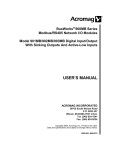
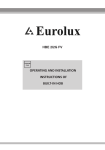
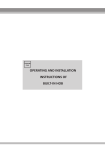
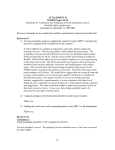
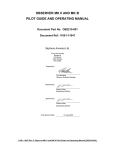
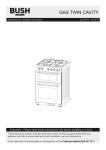
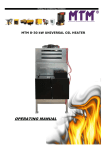
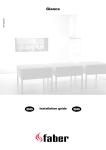


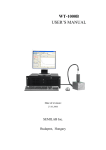
![Page 1 of 9 Section A – Multiple Choice Questions [20 marks] NOTE](http://vs1.manualzilla.com/store/data/005683805_1-bbf54c1c016690de236e51ec0151b7b8-150x150.png)
